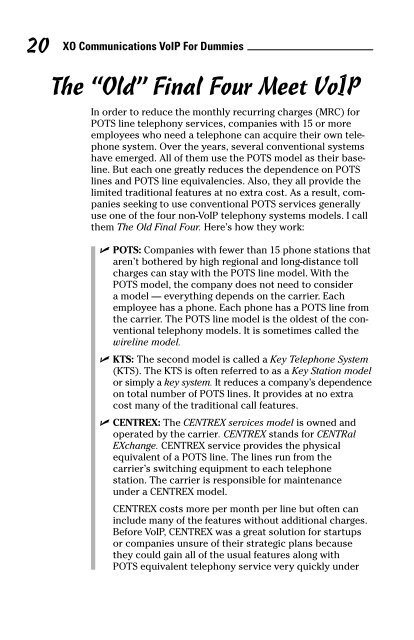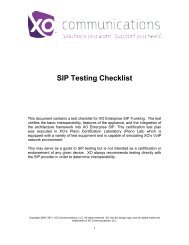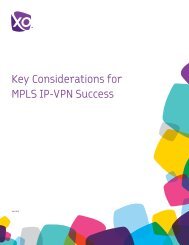VoIP for Dummies Book - XO Communications
VoIP for Dummies Book - XO Communications
VoIP for Dummies Book - XO Communications
You also want an ePaper? Increase the reach of your titles
YUMPU automatically turns print PDFs into web optimized ePapers that Google loves.
20<br />
<strong>XO</strong> <strong>Communications</strong> <strong>VoIP</strong> For <strong>Dummies</strong><br />
The “Old” Final Four Meet <strong>VoIP</strong><br />
In order to reduce the monthly recurring charges (MRC) <strong>for</strong><br />
POTS line telephony services, companies with 15 or more<br />
employees who need a telephone can acquire their own telephone<br />
system. Over the years, several conventional systems<br />
have emerged. All of them use the POTS model as their baseline.<br />
But each one greatly reduces the dependence on POTS<br />
lines and POTS line equivalencies. Also, they all provide the<br />
limited traditional features at no extra cost. As a result, companies<br />
seeking to use conventional POTS services generally<br />
use one of the four non-<strong>VoIP</strong> telephony systems models. I call<br />
them The Old Final Four. Here’s how they work:<br />
� POTS: Companies with fewer than 15 phone stations that<br />
aren’t bothered by high regional and long-distance toll<br />
charges can stay with the POTS line model. With the<br />
POTS model, the company does not need to consider<br />
a model — everything depends on the carrier. Each<br />
employee has a phone. Each phone has a POTS line from<br />
the carrier. The POTS line model is the oldest of the conventional<br />
telephony models. It is sometimes called the<br />
wireline model.<br />
� KTS: The second model is called a Key Telephone System<br />
(KTS). The KTS is often referred to as a Key Station model<br />
or simply a key system. It reduces a company’s dependence<br />
on total number of POTS lines. It provides at no extra<br />
cost many of the traditional call features.<br />
� CENTREX: The CENTREX services model is owned and<br />
operated by the carrier. CENTREX stands <strong>for</strong> CENTRal<br />
EXchange. CENTREX service provides the physical<br />
equivalent of a POTS line. The lines run from the<br />
carrier’s switching equipment to each telephone<br />
station. The carrier is responsible <strong>for</strong> maintenance<br />
under a CENTREX model.<br />
CENTREX costs more per month per line but often can<br />
include many of the features without additional charges.<br />
Be<strong>for</strong>e <strong>VoIP</strong>, CENTREX was a great solution <strong>for</strong> startups<br />
or companies unsure of their strategic plans because<br />
they could gain all of the usual features along with<br />
POTS equivalent telephony service very quickly under






